The UK national debt is the total amount of money the British government owes to the private sector and other purchasers of UK gilts (e.g. Bank of England).
- UK public sector net debt (ex public sector banks) was £2,685.6 billion or 98.1% of GDP (20 Dec 2024).
- The OBR have forecast substantial rises in UK debt over the coming decade because of demographic factors, putting strain on UK spending.
- Source: [1. ONS public sector finances,- HF6X] (page updated 20 Jan 2024)
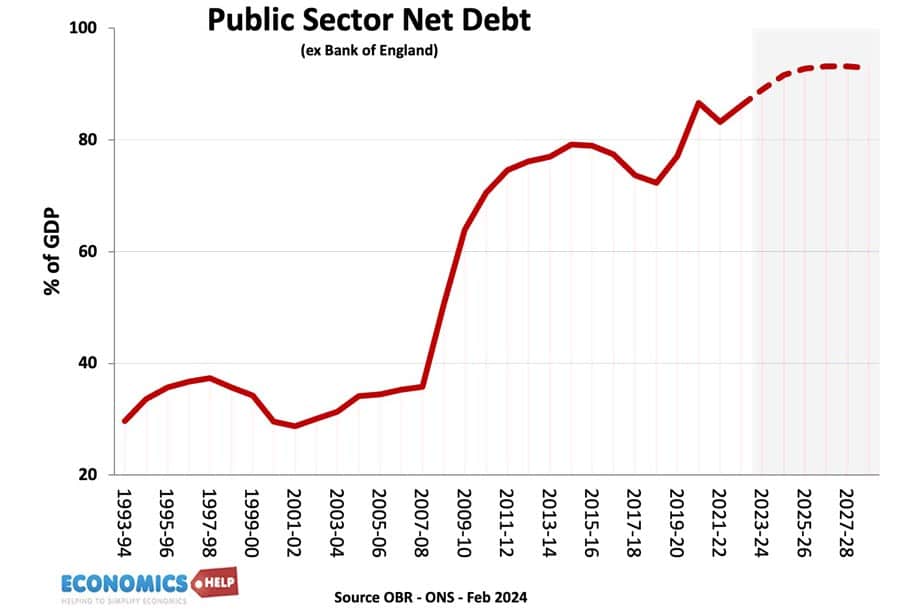
Source: ONS debt as % of GDP – HF6X | PUSF – public sector finances at ONS
Reasons for National debt
- Enables the government to spend more during periods of national crisis, e.g wars, pandemics, and recessions.
- In a recession, the government will automatically receive lower tax revenues (less VAT and income tax) and will have to spend more on benefits (e.g. more unemployment benefits) This causes a cyclical rise in debt.
- Extra government borrowing during a recession can help provide fiscal stimulus to promote economic recovery. By borrowing and then spending more, the government is injecting demand into the economy and this can help to reduce unemployment. This is known as fiscal policy and was advocated by J.M. Keynes.
- Strong market demand for government debt. Private investors buy gilts because they are seen as risk-free investments and there is also an annual dividend from the bond yield. Since 2009, there has been strong demand despite very low-interest rates, meaning the government can borrow very cheaply.
- Finance investment. The government could borrow to finance public investment projects that can lead to higher growth in the future.
- Political convenience. There is usually political pressure to cut taxes and increase government spending. Allowing debt to rise can be a way for the government to avoid difficult choices.
Forecast for the National debt?
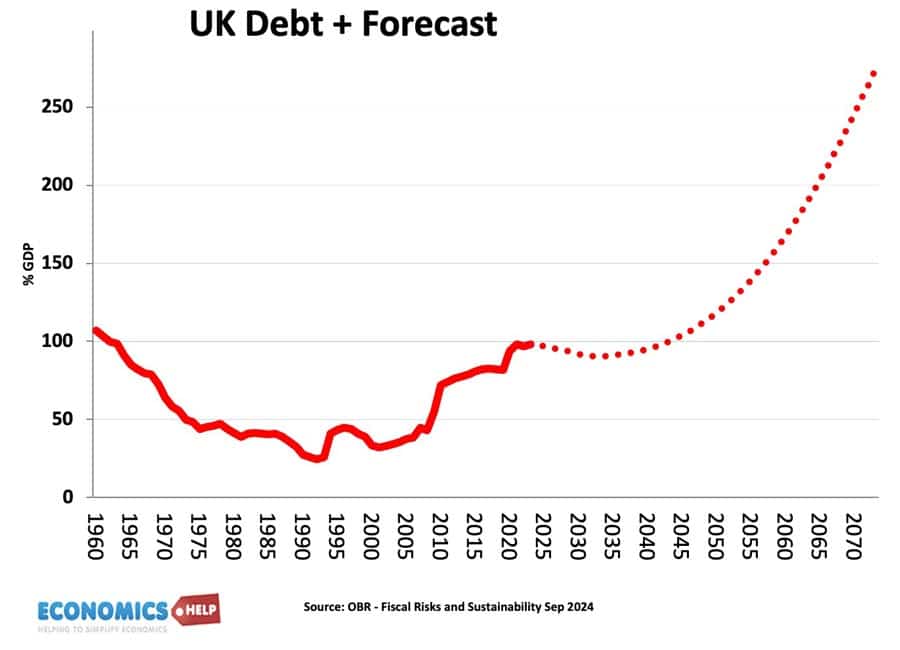
Source: Fiscal risks and sustainability – OBR – Economic and Fiscal Outlook Oct 2024
The OBR have forecast that, on our given trajectory, UK public sector debt could reach 350% of GDP within 50 years. The pessimistic outlook for national debt is made because
- An ageing population and demographic changes will put increased pressure on government spending, notably health care and pension spending.
- A smaller working population will limit UK’s productive capacity.
- Stress on finances from geopolitical events, such as frostier relations with China, Russia and the Middle East.
- Higher energy prices
- Costs of climate change.
- Declining tax revenues from petrol in a decarbonising economy.
- Low productivity growth of UK since the financial crash of 2009
- Recent boost to debt from the financial crisis and one-off cost of Coronovirus pandemic, which cut tax revenues and required government support for lockdown measures.
UK debt in context
Predicting debt for the next 50 years is difficult since we don’t know what kind of productivity improvements may come, e.g. continued gains in renewable energy may reduce the burden of higher oil and gas prices. Equally, the costs of environmental change could be worse.
History of the national debt

Main article: History of UK national debt
UK national debt since 1900
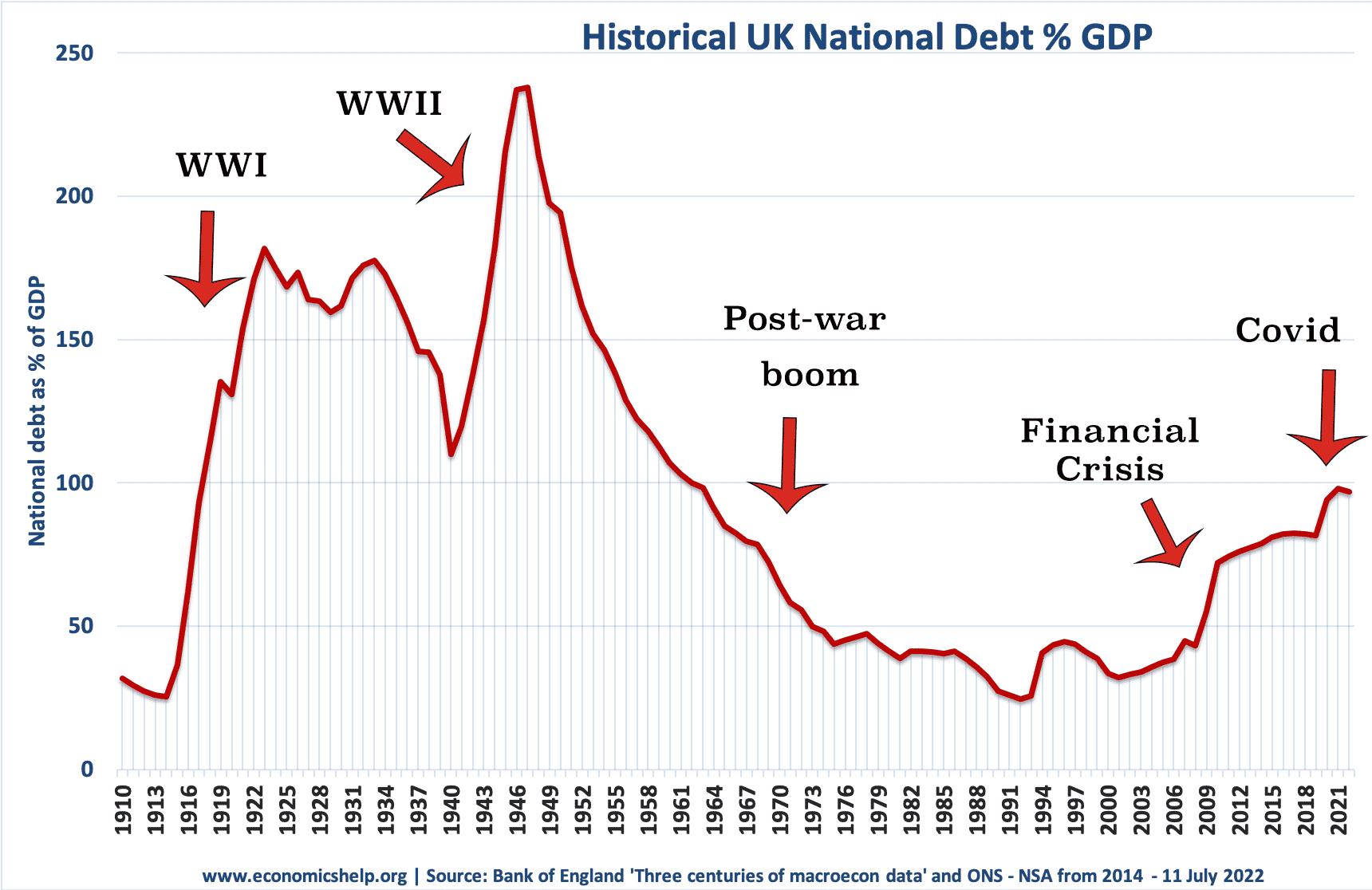
Source: Reinhart, Camen M. and Kenneth S. Rogoff, “From Financial Crash to Debt Crisis,” NBER Working Paper 15795, March 2010. and OBR from 2010.
These graphs show that government debt as a % of GDP has been much higher in the past. Notably in the aftermath of the two world wars. This suggests that current UK debt is manageable compared to the early 1950s. (note, even with a national debt of 200% of GDP in the 1950s, UK avoided default and even managed to set up the welfare state and NHS.
Debt reduction and growth
The post-war levels of national debt suggest that high debt levels are not incompatible with rising living standards and high economic growth.
- The reduction in debt as a % of GDP 1950-1980 was primarily due to a prolonged period of economic growth. See: how the UK reduced debt in the post-war period
- This contrasts with the experience of the UK in the 1920s when in the post First World War, the UK adopted austerity policies (and high exchange rate) but failed to reduce debt to GDP. Debt in Post-First World War period.
Budget deficit – annual borrowing
This is the amount the government has to borrow per year.
- Government
- borrowing in the financial year to December 2024 was £129.9
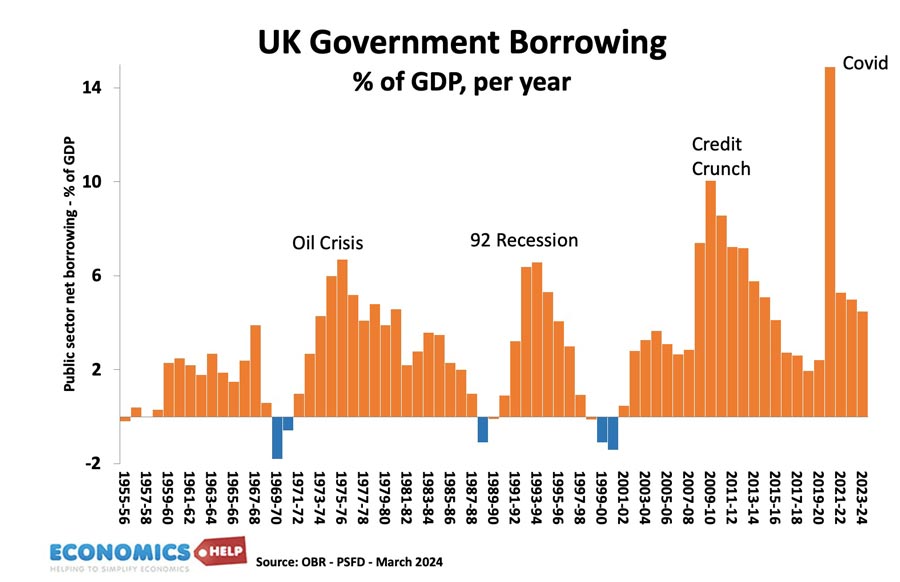
Annual borrowing since 1950. Figures for 2023-24 are forecasts (and rather optimistic!)
Debt and bond yields
Bond yields a the interest that the government pay bond/gilt holders. It reflects the cost of borrowing for the government. Lower bond yields reduce the cost of government borrowing.
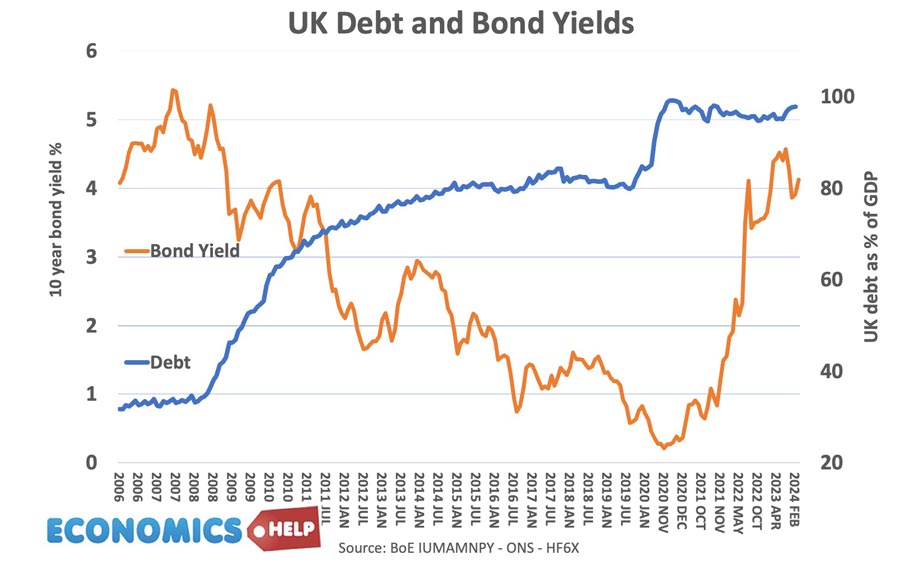
Between 2007 and 2020, UK bond yields fell. Countries in the Eurozone with similar debt levels saw a sharp rise in bond yields putting greater pressure on their government to cut spending quickly. However, being outside the Euro with an independent Central Bank (willing to act as lender of last resort to the government) means markets don’t fear a liquidity crisis in the UK; Euro members who don’t have a Central Bank willing to buy bonds during a liquidity crisis have been more at risk to rising bond yields and fears over government debt.
See also: Bond yields on European debt | (reasons for falling UK bond yields)
Since 2021, bond yields have risen due to pick up in inflation
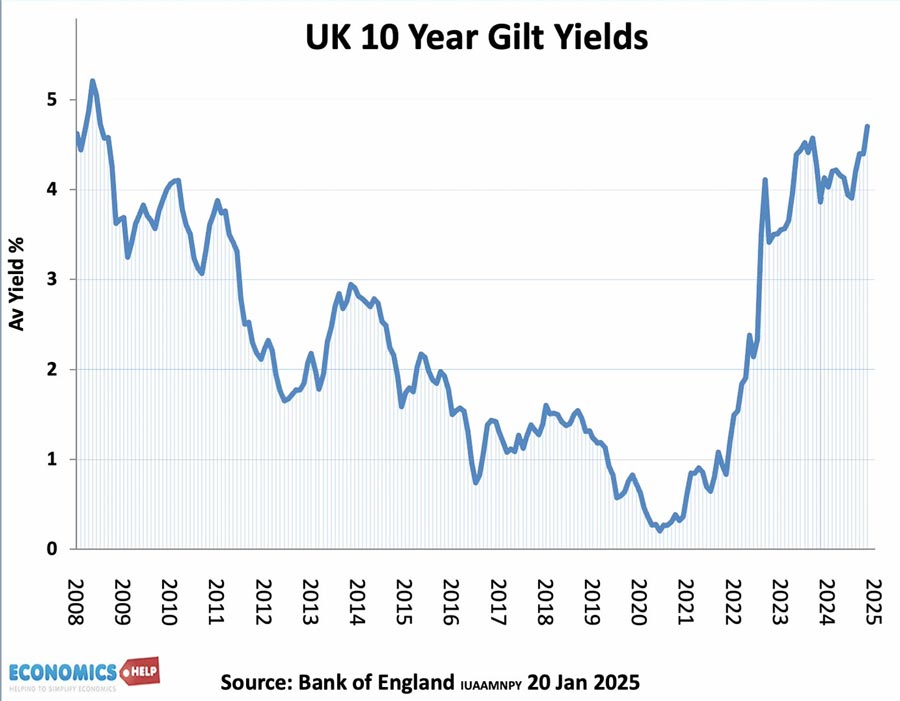
Cost of Interest Payments on National Debt
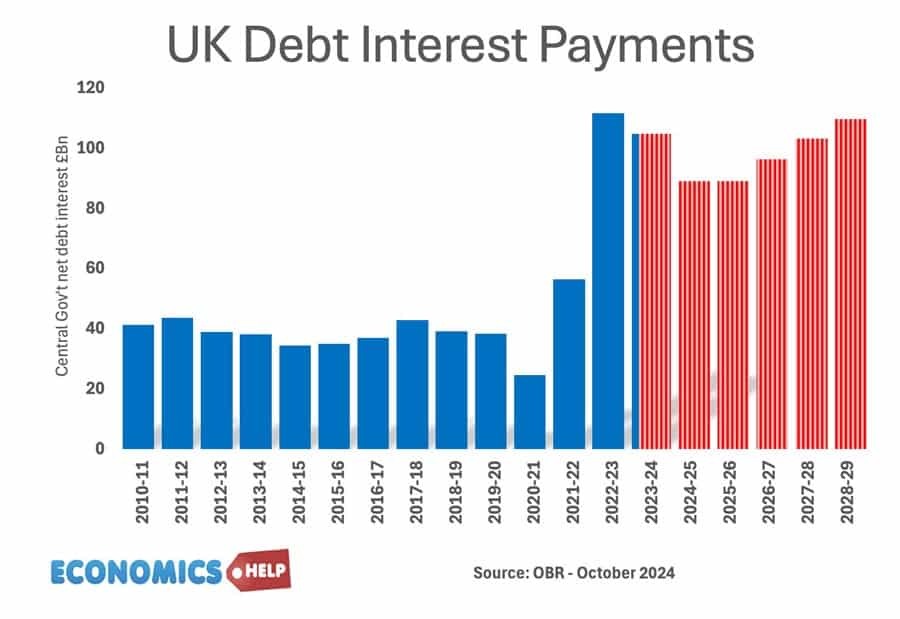
The cost of National debt is the interest the government has to pay on the bonds and gilts it sells. According to the OBR in 2023-24, debt interest payments will be £108 billion. (3.2% of GDP) or 5.2% of total spending. It is lower than in previous decades because of lower bond yields.
See also: UK Debt interest payments
The era of low interest rates post 1992 helped to reduce UK debt interest payments as a ratio of government revenue. However, with interest rates and borrowing increasing – debt interest cost have increased significantly.
Potential problems of National Debt
- Interest payments. The cost of paying interest on the government’s debt is very high. In 2011 debt interest payments will be £48 billion a year (est 3% of GDP). Public sector debt interest payments will be the 4th highest department after social security, health and education. Debt interest payments could rise close to £70bn given the forecast rise in national debt.
- Higher taxes / lower spending in the future.
- Crowding out of private sector investment/spending.
- The structural deficit will only get worse as an ageing population places greater strain on the UK’s pension liabilities. (demographic time bomb)
- Potential negative impact on the exchange rate (link)
- Potential of rising interest rates as markets become more reluctant to lend to the UK government.
However, government borrowing is not always as bad as people fear.
- Borrowing in a recession helps to offset a rise in private sector saving. Government borrowing helps maintain aggregate demand and prevents a fall in spending.
- In a liquidity trap and zero interest rates, governments can often borrow at very low rates for a long time (e.g. Japan and the UK) This is because people want to save and buy government bonds.
- Austerity measures (e.g. cutting spending and raising taxes) can lead to a decrease in economic growth and cause the deficit to remain the same % of GDP. Austerity measures and the economy | Timing of austerity
Who owns UK Debt?
The majority of UK debt used to be held by the UK private sector, in particular, UK insurance and pension funds. In recent years, the Bank of England has bought gilts taking its holding to 25% of UK public sector debt.

Source: DMO Debt Management Report 2022/23
- Overseas investors own about 28% of UK gilts (2022).
- The Asset Purchase Facility is purchases by the Bank of England as part of quantitive easing. This accounts for 26% of gilt holdings.
Total UK Debt – government + private
- Another way to examine UK debt is to look at both government debt and private debt combined.
- Total UK debt includes household sector debt, business sector debt, financial sector debt and government debt. This is over 500% of GDP. Total UK Debt
Private sector savings
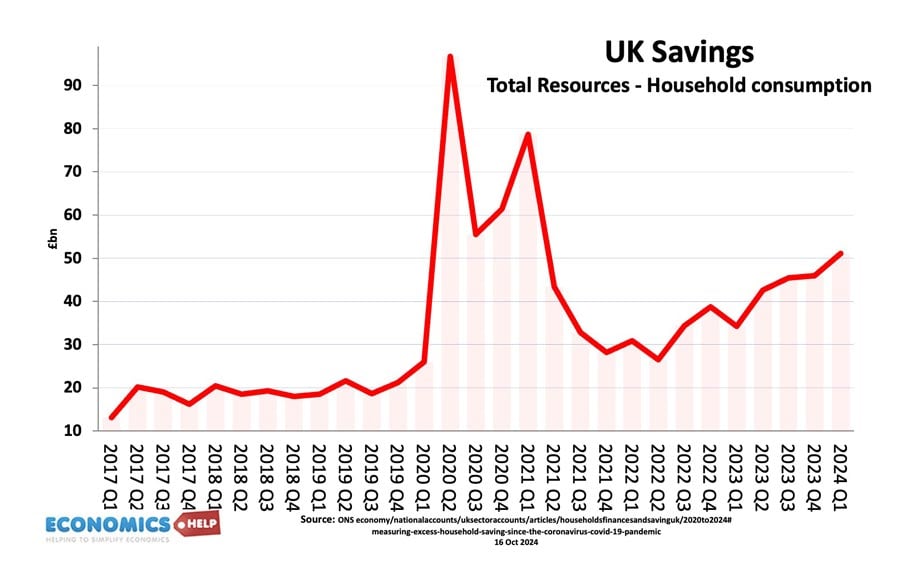
When considering government borrowing, it is important to place it in context. From 2007 to 2012, we have seen a sharp rise in private sector saving (UK savings ratio). The private sector has been seeking to reduce their debt levels and increase savings (e.g. buying government bonds). This increase in savings led to a sharp fall in private sector spending and investment. The increase in government borrowing is making use of this steep increase in private sector savings and helping to offset the fall in AD. see: Private and public sector borrowing
Comparison with other countries
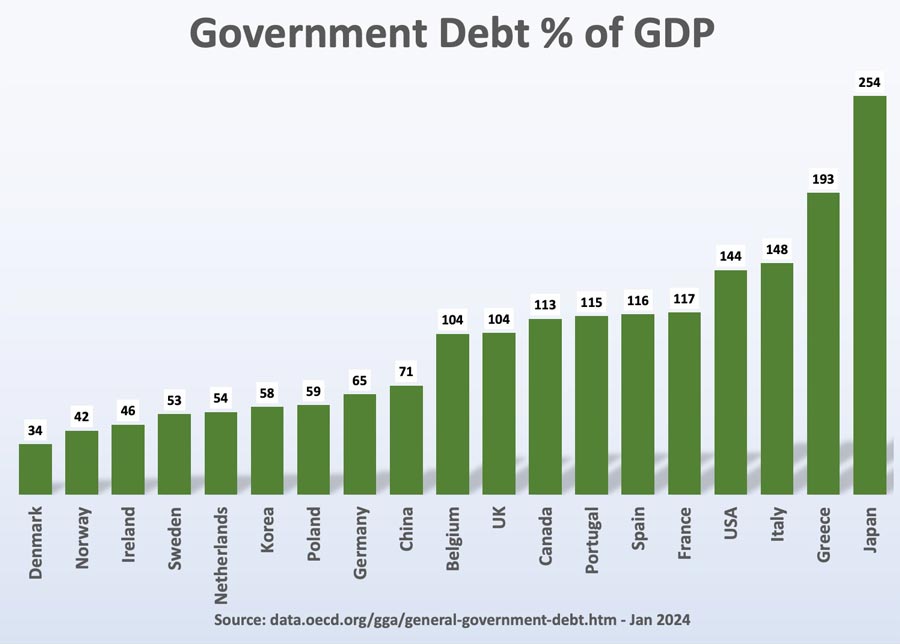
Although 107% of GDP is high by recent UK standards, it is worth bearing in mind that other countries have a much bigger problem. Japan, for example, has a National debt of 256%, Italy is over 157%. The US national debt is over 132% of GDP. [See other countries debt].
How to reduce the debt to GDP ratio?
- Economic expansion which improves tax revenues and reduces spending on benefits like Job Seekers Allowance. The economic slowdown which has occurred since 2010 has pushed the UK into a period of slow economic growth – especially if we consider GDP per capita growth. Therefore the further squeeze on tax revenues has led to deficit-reduction targets being missed.
- Government spending cuts and tax increases (e.g. VAT) which improve public finances and deal with the structural deficit. The difficulty is the extent to which these spending cuts could reduce economic growth and hamper attempts to improve tax revenues. Some economists feel the timing of deficit consolidation is very important, and growth should come before fiscal consolidation.
- See: practical solutions to reducing debt without harming growth
Other countries debt
See also:

National debt is normally expressed as a percentage of GDP. Surely it would also be useful to express it as a percentage of public sector income?
“The interest is paid i presume, to the bank of england that lends the money to our government”
Alas wrong – it is paid to the banks that lent us the money via the international gilt market.
The Bank of England has no money to lend to anyone, it merely uses the bond market to create “banking credit”, for which we pay interest to the bond holder/s for the privilege.
The scary part is this money doesn’t actually exist, it is fabricated into existance on the back of our government’s “promise to pay”. So we effectively pay interest on money that doesn’t exist and was “printed” by a bank!
I would suggest starting with video here:
http://video.google.co.uk/videoplay?docid=-2550156453790090544#
i dont know where you get the idea we have low taxation in the UK, just because we pay a lesser percentage under paye than we did in the 60’s doesnt mean we now pay less, vat wasnt around then for a start, cigarettes,spirits,road tax,petrol etc were all less taxed than they are now,
we didnt have taxes on taxes like landfil tax back then neither, the labour gov spent money it didnt have like it was going out of fashion , because taxpayers werent being made to pay for it they didnt bother to question,
now its time to pay back for the squander and people might start to realise you shouldnt buy lots of things on credit (especially PFI credit).
Up to a dozen years or so ago refunds of pension fund surpluses were made to businesses and the Government was happy to collect tax of initially 10%, later increasing to 20%. This, I believe, was due to, 1) a higher proportion of employees paying in compared to pensioners, 2) the value of shares being higher. The businesses, (I have used, businesses as some were in the private other public and ex-public sector) had the excuse that, ‘they had to reduce the surplus, due to Inland Revenue rules.’ They could have paid higher benefits to the pensioners, or given the employees a contributions holiday. To me it was obvious that as many of the schemes had not been around for more than 40 years, there was going to be a time when the current employees were to be due the full pension, which they will now not receive. You never hear about the Government retuning the 10% or 20% tax or the businesses the balance, back to pension funds. All they say is that, ’employees with have lower pension than they would expect ‘. I wonder why people do not save as much for pension as the Government would like.
Why is ratio of government debt to GDP commonly used as a measure? The general public is much more familiar with the ratio of debt to income – a ratio of 3-4 has commonly been used as a guideline for mortgage borrowing. What is the ratio of current government debt to total tax/NI receipts?
anyone knows where i could get datas for UK public sector net debt ?
trying to find but can’t get anything ;(
The country is in debt and most of the UK people are in debt – the country is facing spending cuts and every British Citizen faces extra tax on wages etc etc! Every where is doom and gloom!
People need to look at what is really important in life!.. I owe £55,000 of unsecured debt and I’ve just entered into a Debt Management Plan – But I’m still the richest person I know as I have a loving wife and two fantastic kids. I’m in love and I’m happy – that makes me rich.
My debt has come from buying materialist objects, and love and happiness is something money can not buy. This lesson in life cost me £55,000!
So forget about debt and the control it has on the country and the people! Live for today!
If the interest on the National Debt is only 2.5% of GDP, why isn’t it being carried until better days rather than imposing cuts that will cause real human suffering e.g. freezing NHS budgets and taking money out of the economy thus helping put people out of work and onto welfare!
Where can one see exactly to whom our National Debt is owed and what interest rates are payable?
Its quite shocking how much the UK owe’s the tories have screwed this country badly, the cuts will keep getting harder as times move on.
Some people do not realise that Brown Labour borrowed madly and left us paying about £50 BN a year interest. Labour government spent 1/3 more than it collected. They borrowed extra money to try to make whole regions depend on the State for jobs and welfare.
That was all to make people vote Labour. The last thing Labour wants is prosperous thinking voters who run their own independent businesses, who want less tax and less State interference. Labour want more tax and more State interference, so they need the stupidest State officials who follow orders from Labour HQ.
Keynes aimed to create surplus in tax during booms when Govt collects more than it spends, then use the surplus during recession. Mad Brown repeated ‘I ended boom and bust’. Probably the stupidest statement ever made. He loaded everyone with debts. He put each UK person into about £100,000 of debt!!
He spent billions more than he collected during boom and hid £3.5 Trillion of borrowing and pension liability. So when bust came he borrowed even more.
Now in reality the UK has near £5 Trillion of debts and pension liabilities. Brown and Labour cowards were too afraid, or too incompetent, or too venally corrupt to run UK the finances properly.
They have left the UK in huge debt, interest paments more than almost all State services.
Brown, Bliar, Mandy, Campbell, Beckett, Straw, Balls, Cooper, Milipede and co should all be tried for fraud and corruption. Then banned from public service and being a Director, fined and jailed for at least 20 years. They have left the UK in debt prison for far longer.
I imagine you are a Daily Mail or a Sun reader Where on earth do you get these ridiculous figures from ?
No one could deny that Labour spent a fair bit of dosh. Of course after twenty years of Tory slash and burn there was lots to spend on. The NHS, new hospitals Health Centres Schools etc.
Have a look at your historical graphs and you will see which governments are the spendthrifts (and why) In particular, have a look and see when the debt really started to grow Yes that’s right following the debacle of 2008.
When un-regulated banks had a good laugh at us all
The biggest mistake Brown made was to bail the banks out. In hindsight he should have let them go under.
The banks have left us in debt!!! Have a look at the graph above for public sector debt including ‘Financial Services Intervention’
So if the way the banking system works means most money is created by private banks(by ways of Fractional Reserve Banking), rather than by the state, this obviously has a wide range of destructive effects, include the high level of public, private and corporate debt, Third World debt, rising costs of living and falling living standards, and the recent financial crisis. Also the fact that Government borrows money at interest (by way of gilt edged securities etc).
My question is this… Why does Government allow private banks to create money by way of loans, mortgages etc ie Fractional reserve Banking? Why does Government not create its own money, interest free (saving roughly 30 billion of tax payers money per year)? and why doesn’t Government just get rid of Fractional Reserve Banking all together?
Surely it is possible for newly created money to enter the economy as a debt-free stimulus, rather than as debt.
you wonder the way back from all this . . .